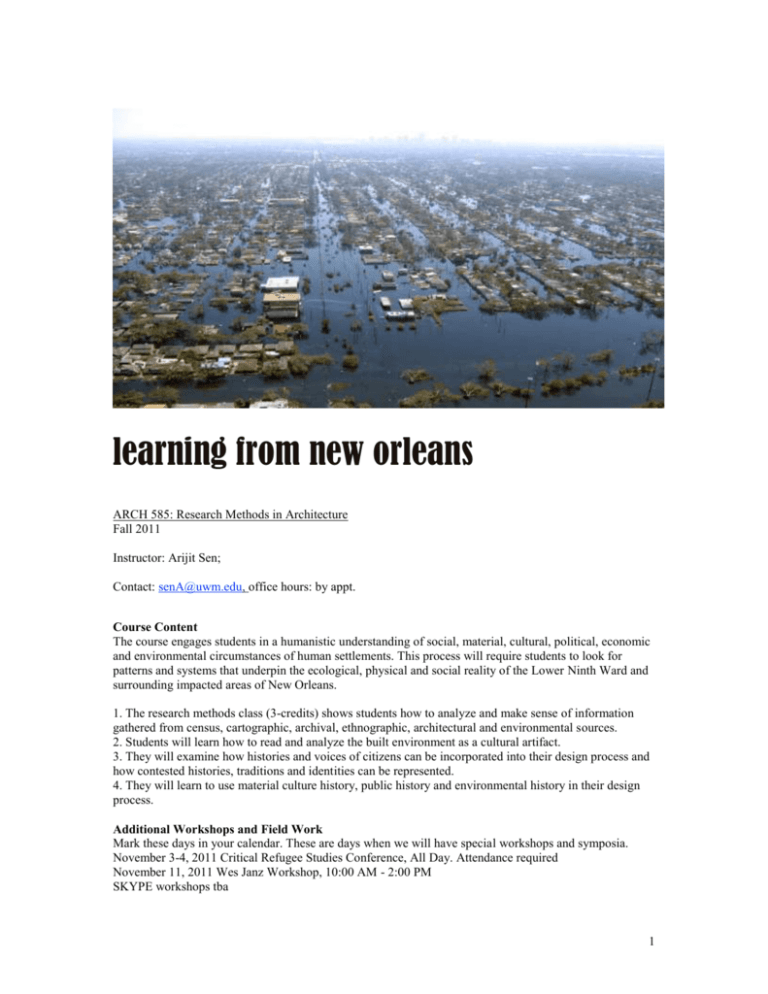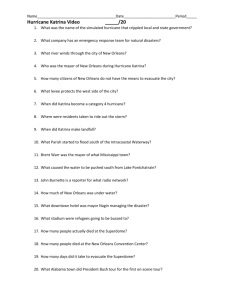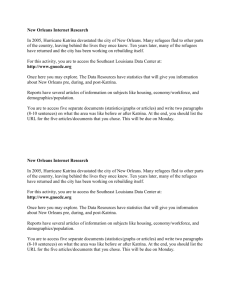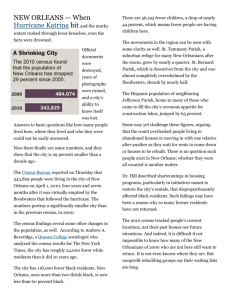learning from new orleans ARCH 585: Research Methods in
advertisement

learning from new orleans ARCH 585: Research Methods in Architecture Fall 2011 Instructor: Arijit Sen; Contact: senA@uwm.edu, office hours: by appt. Course Content The course engages students in a humanistic understanding of social, material, cultural, political, economic and environmental circumstances of human settlements. This process will require students to look for patterns and systems that underpin the ecological, physical and social reality of the Lower Ninth Ward and surrounding impacted areas of New Orleans. 1. The research methods class (3-credits) shows students how to analyze and make sense of information gathered from census, cartographic, archival, ethnographic, architectural and environmental sources. 2. Students will learn how to read and analyze the built environment as a cultural artifact. 3. They will examine how histories and voices of citizens can be incorporated into their design process and how contested histories, traditions and identities can be represented. 4. They will learn to use material culture history, public history and environmental history in their design process. Additional Workshops and Field Work Mark these days in your calendar. These are days when we will have special workshops and symposia. November 3-4, 2011 Critical Refugee Studies Conference, All Day. Attendance required November 11, 2011 Wes Janz Workshop, 10:00 AM - 2:00 PM SKYPE workshops tba 1 Teaching Methods This class follows a teaching strategy called Problem-Based-Learning (PBL) where resolving real life problems are planned into the curriculum in ways that promote higher-level cognitive learning. PBL is a teaching method that is best applied in the study of complex knowledge domains such as culture and architectural design where there is no single scientific answer or resolution. Problems based learning principles also allow students to apply and evaluate complex information that they encounter during research directly into their design. Learning Objectives On completion of this class students will gain the following skills. 1. An ability to collect empirical data and do fieldwork. 2. An awareness of ethnographic, archival, architectural, observational, and ecological data collection strategies and an understanding of interpretive, qualitative and correlational analysis. An ability to collect, analyze, synthesize and evaluate material and social data. 3. An ability to craft a thesis statement and produce an appropriate program of inquiry. 4. An ability to evaluate and apply information. 5. An ability to take an informed position on the politics of urban rebuilding, sustainability, and social engagement. NAAB Criteria Addressed Speaking and Writing Skills Human Behavior Critical Thinking Skills Human Diversity Graphics Skills Sustainable Design/ Social Equity and Public History Research Skills Program Preparation Fundamental Design Skills Site Conditions Collaborative Skills Client Role in Architecture National and Regional Traditions Ethics and Professional Judgment Texts: Required Ernest T. Stringer, Action Research, (Thousand Oaks: Sage Publications, Inc., 2007) Phil Steinberg and Rob Shields, What is a City: Rethinking the Urban after Hurricane Katrina, (Athens: University of Georgia Press, 2008) Eugenie Ladner Birch and Susan M. Wachter. Rebuilding Urban Places after Disaster: Lessons from Hurricane Katrina. (Philadelphia: University of Pennsylvania Press, 2006) Ash Amin and Nigel Thrift, Cities: Reimagining the Urban, (New York: Polity, 2002) Nora Neale Hurston, "Their Eyes Were Watching God," (New York: Harper Perennial Books, 1996) Recommended: The following books are held on reserve in the Resource Center and/or in the Library (do not buy) Ila Berman and Mona El Khafif, Urban/Build Local/Global, (California: William Stout, 2009) Emily Talen, Design for Diversity: Exploring Socially Mixed Neighborhoods, (Architectural Press, 2008); Eve Blau and Ivan Rupnik, Project Zagreb: Transition as Condition, Strategy, Practice, (New York: Actar D, 2007) This is a Buildings-Landscapes-Cultures Course (www.blcprogram.org) 2 Jeff Hou, Jeff Hou, (ed), Insurgent Public Space: Guerrilla Urbanism and The Remaking of Contemporary Cities (Kentucky: Taylor and Francis Group, 2010) Charles Waldheim, ed. The Landscape Urbanism Reader, (New York: Princeton University Press, 2006) Strategies This semester we will look at the New Orleans case study via three “systems.” These are strategies that will help us understand the situation on the ground better. These systems include a) infrastructural system, b) ecological system, c) the lived system. Students are first required to analyze and document each of these systems separately. In addition to the systemic lenses we test 5 ordering strategies viz. transect or cross sections, thick edge, sequential procession, layering, material assemblage in our design process. Unlike other studios students will have create their own project/program statement and carefully reflect on the design process/methods. Roles In addition to being designers, students will also play the role of research specialists that will allow them to focus on specific skills of information collection and knowledge domains. These roles include a) historian, b) ethnographer, and c) Ecologist. These roles will be further explained in class. Schedule Friday mornings are group workshops on research methods (except November 4 and 11) Grades and Grading Readings and discussions The course is a collective endeavor. Your participation in class discussion is paramount: essential and expected. As such, you need to read all of the assigned readings and critically think about the issues posed in them before each class. Class sessions should have a constructive and reflective atmosphere in which all participate, discussing their thoughts and concerns, and providing useful, constructive feedback. The instructor’s role is as facilitator, discussant, resource, devil's advocate, occasional protagonist, and eventual evaluator. Class discussions will be judged by the flexibility and critical ability of a student to evaluate and value the different perspective intentions, positions, and purposes of the area of study. In that respect it is important for students to display the ability to questions perspectives that they are more comfortable with and apply positions they are less familiar with. The discussions should display that the discussant is ready to question, reconsider, reaffirm, or reconstruct their evolving positions. Students will be called upon to direct discussion every week. 2. Grades Grades are based on the following categories: 20% In class participation Regular attendance Completing assigned readings Leading discussions and sharing ideas Flexibility and critical ability of a student to evaluate and value the different perspective intentions, positions, and purposes of the area of study. Intellectual curiosity, taking intellectual risks, suspending disbelief and trying out ideas that are different 20% New Orleans on site Assignments 20% Reviews and Workshops 40% Projects and assignments, Final Documentation University Policies 3 In this course, university policies and procedures will be followed for academic misconduct, accommodation for disability and religious observation, discriminatory conduct, sexual harassment, and other matters. These are briefly described below. The university has a responsibility to promote academic honesty and integrity and to develop procedures to deal effectively with instances of academic dishonesty. Students are responsible for the honest completion and representation of their work, for the appropriate citation of sources, and for respect of others' academic endeavors. A student may appeal a grade on the grounds that it is based on a capricious or arbitrary decision of the course instructor. Such an appeal shall follow the established procedures adopted by the department and school. These procedures are available in writing from the department chair. If you need special accommodations in order to meet any of the requirements of this course, please contact me as soon as possible. Also, please see me if you anticipate a conflict in attending a class because of a religious observation. Sexual harassment will not be tolerated by the university. It subverts the university's mission and threatens the careers, educational experience, and well-being of students, faculty and staff. The university will not tolerate behavior between or among members of the university community which creates an unacceptable working environment. All projects shall be designed to engage the environment in a way that dramatically reduces or eliminates the need for fossil fuels, and to convey an ethical position in regard to the use of non-renewable materials and materials that pose a threat to human and environmental health. Bibliography Here is a detailed list of books and articles that may be useful during the semester. Majority of them are under reserve in the Main Library under NOI: New Orleans Initiative. Go to https://millib.wisconsin.edu/vwebv/enterCourseReserve.do Under the course pull-down menu choose NOI: New Orleans Initiative and find the books and readings. New Orleans Books and Articles All New Orleans related books are on reserve at the Golda Meir Library under New Orleans Initiative (Go to the Reserves Page) Demographic and Cultural Diversity, politics of citizenship and belonging 1. Emily Talen, Design for Diversity: Exploring Socially Mixed Neighborhoods (UK, London: Architectural Press, 2008) 2. Emily Talen, Urban Design Reclaimed: Tools, Techniques, and Strategies for Planners (California: Amer Planning Assn, 2009) 3. Emily Talen, Diversity as if it Mattered, http://www.terrain.org/essays/17/talen.htm 4. Ali Madanipour, Ali Madanipour, ed, Whose Public Space: International Case Studies in Urban Design (Kentucky: Taylor and Francis Group, 2010) 5. Jeff Hou, Jeff Hou, ed, Insurgent Public Space: Guerrilla Urbanism and The Remaking of Contemporary Cities (Kentucky: Taylor and Francis Group, 2010) 6. Nan Elin, Integral Urbanism (New York: CRC Press, 2006) 7. Henry Jenkins, “People from that part of the world”: The Politics of Dislocation Cultural Anthropology, Volume 21, Issue 3 (August 2006), pp 469-486 http://onlinelibrary.wiley.com/doi/10.1525/can.2006.21.3.469/abstract 8. George Lipsitz, “Learning from New Orleans: The Social Warrant of Hostile Privatism and Competitive Consumer Citizenship” Cultural Anthropology, Volume 21, Issue 3 (August 2006), pp 451-468 http://onlinelibrary.wiley.com/doi/10.1525/can.2006.21.3.451/abstract 9. Michael K. J. Fischer, “Introduction to Culture at Large Forum with George Lipsitz: Social Warrants and Rethinking American Culture” Cultural Anthropology, Volume 21, Issue 3 (August 2006), pp 447450 http://onlinelibrary.wiley.com/doi/10.1525/can.2006.21.3.447/abstract 10. Kim Forth, “Cultural Critique in and of American Culture” Cultural Anthropology, Volume 21, Issue 3 (August 2006), pp 496-500 http://onlinelibrary.wiley.com/doi/10.1525/can.2006.21.3.496/abstract 11. Eran Ben –Joseph, The Code of the City: Standards and the Hidden Language of Place Making (MA: MIT Press, 2005) 12. Karen Franck and Quentin Stevens, Karen Franck and Quentin Stevens, ed, Loose Space: Possibility and Diversity in Urban Life (New York: Routledge, 2007) 13. Jane Jacobs, Death and Life of Great American Cities (Vintage Books, the University of Michigan, 1992) This is a Buildings-Landscapes-Cultures Course (www.blcprogram.org) 4 14. Iain Borden, Iain Borden, Joe Kerr, Jane Rendell and Alicia Pivaro, ed, The Unknown City: Contesting Architecture and Social Space (MA: MIT Press, 2002) 15. Setha M Low, Plaza’s: The Politics of Public Space and Culture (Texas: University of Texas Press, 16. 17. 18. 2000) Peirce Fee Lewis, New Orleans: the Making of an Urban Landscape (Columbia College Chicago: Center for American Places, 2003) Richard Campanella, Geographies of New Orleans: Urban Fabrics Before the Storm (Center for Louisiana Studies: University of Louisiana at Lafayette, 2006) Richard Campanella, , “Ethnic Geographies of New Orleans”, Geographies of New Orleans: Urban Fabrics Before the Storm (Center for Louisiana Studies: University of Louisiana at Lafayette, 2006) History Culture and Memory 19. Dell Upton, “The Urban Cemetery and the Urban Community: The Origin of the New Orleans Cemetery.” in Exploring Everyday Landscapes: Perspectives in Vernacular. Architecture VII, ed. Annmarie Adams and Sally McMurry (Knoxville: University of Tennessee Press, 1997), pp.131-45. 20. Dolores Hayden, Power of Place: Urban Landscapes as Public History (MA: MIT Press, 1997) Ecological and infrastructural Patterns 21. Craig E. Colten, An Unnatural Metropolis: Wresting New Orleans from Nature (Louisiana: Louisiana State University Press, 2006) 22. Dell Upton, “The Master Street of the World: The Levee.” in Streets: Critical Perspectives on Public Space, ed. Zeynep Celik, Diane Favro and Richard Ingersoll (Berkeley: University of California Press, 1996), pp. 277-88. 23. Ari Kelman, A River and Its City (CA: University of California Press, Berkeley, CA, 2003) 24. Till, Karen E. In Press. “Greening the City? Artistic Re-Visions of Sustainability in Bogota” emisferica, 2009-2010, http://hemisphericinstitute.org/hemi/en/e-misferica-71/till (August 22, 2010). 25. All Issues, e-misférica , Hemispheric Institute of the Americas http://hemisphericinstitute.org/hemi/en/all-issues, (August 22, 2010) 26. Gisela Canepa Koch, “The Public Sphere and Cultural Rights: Culture as Action,” Pontificia Universidad Catolica del Peru, 2009-2010, http://hemisphericinstitute.org/hemi/en/e-misferica62/canepa-koch, (August 22, 2010) 27. Carol Burns and Andrea Kahn, Site Matters (New York: Routledge, 2005) 28. Georgia Daskalakis, Charles Waldheim and Jason Young, Stalking Detroit (Actar, 2001) 29. Charles Waldheim and Charles Waldheim, ed, Case: Lafayette Park Detroit (New York: Prestel, 2004) 30. Peter Shedd Reed, Groundswell: Constructing the Contemporary Landscape (New York: The Museum of Modern Art, 2005) 31. Mohsen Mostafavi, Harvard University, Mohsen Mostafavi and Gareth Doherty, ed, Ecological Urbanism (Lars Muller Publisher, 2010) Spatial, geographical, and architectural Patterns 32. Anita Drever, “New Orleans: a Re-emerging Latino Destination City” in Journal of Cultural Geography, 2008, 287-303 33. Stephen Verderber, Delirious New Orleans: Manifesto for an Extraordinary American City (Austin: University of Texas Press, 2009) 34. Richard Campanella, Time and Place in New Orleans: Past Geographies in the Present Day (Louisiana: Pelican publishing company, 2002) 35. Richard Campanella, Marina Campanella, New Orleans Then and Now (Louisiana: Pelican publishing company, 1999) 36. Richard Campanella, Bienville’s Dilemma: A Historical Geography of New Orleans (Center for Louisiana Studies, University of Louisiana at Lafayette, 2008) 37. Richard Campanella, Geographies of New Orleans: Urban Fabrics Before the Storm (Center for Louisiana Studies: University of Louisiana at Lafayette, 2006) 5 38. Richard Campanella, , “Ethnic Geographies of New Orleans,” Geographies of New Orleans: Urban Fabrics Before the Storm (Center for Louisiana Studies: University of Louisiana at Lafayette, 2006) 39. Peirce Fee Lewis, New Orleans: The Making of an Urban Landscape (Urban Landscape (Columbia 40. 41. 42. 43. 44. 45. 46. 47. 48. 49. 50. college Chicago: Center for American Places, 2003) Li Wei, Airriess Christopher, Chen Angela Chia-Chen, Leong Karen J, Keith Verna M, Adams Karen L, “Surviving Katrina and its aftermath: evacuation and community mobilization by Vietnamese Americans and African Americans, Journal of Cultural Geography, October 01, 2008. Dell Upton, “Grid as Design Method: The Spatial Imagination in Early New Orleans.” in Architecture –Design Methods –Inca Structures: Festschrift for Jean-Pierre Protzen, ed. Hans Dehlinger and Johanna Dehlinger (Kassel: Kassel University Press, 2009), pp. 174-81. Dell Upton, “Understanding New Orleans’ Architectural Ecology,” in Rebuilding Urban Places After Disaster: Lessons from Hurricane Katrina, ed. Eugenie L. Birch and Susan M. Wachter (Philadelphia: University of Pennsylvania Press, 2006), pp. 275-87 Dell Upton, “New Orleans: Domestic Social Space,” and “Philadelphia: Health, Reform, Control.” Contributions to Mark P.Leone and Neil Asher Silberman, in Invisible America: Unearthing Our Hidden History (New York: Henry Holt, 1995), pp. 136-49. Ila Berman and Mona El Khafif, Urban/Build Local/Global, (California: William Stout, 009) Eve Blau and Ivan Rupnik, Project Zagreb: Transition as Condition, Strategy, Practice, (New York: Actar D, 2007) Clyde Woods, ed, “In the Wake of Katrina: New Paradigms and Social Visions,” American Quarterly, Volume 61, Number 3 (September 2009) http://muse.jhu.edu/journals/american_quarterly/toc/aq.61.3.html Rebeca Antoine, Voices Rising: Stories from the Katrina Narrative Project, (New Orleans: The University of New Orleans Press, 2008) Peter Marcuse, “From Critical Urban Theory to the Right to the City,” City 13 (June 2009), p. 185 197 All Articles, City 13 (June 2009) “Cities and Diversity: Should We Want It? Can We Plan For It?” In Urban Affairs Review 41 (September 2005), p. 3-19 Electronic Readings Under NOI Antoine, ed. / Voices Rising: Stories from The Katrina Narrative Project / Editor's Introduction & We Thought We Made the Right Decision: The Lozanos: As Told to Caroline Skinner Birch & Wachter, eds. / Rebuilding Urban Places After Disaster: Lessons from Hurricane Katrina / Preface: "The Wound" [by Amy Gutman] & Introduction: Rebuilding Urban Places After Disaster [by Eugenie L. Birch & Susan M. Wachter Bolding / Before and After North Dorgenois: Growing Up in the Sixth Ward / Introduction & Part I: My Family Brinkley / The Great Deluge: Hurricane Katrina, New Orleans, and the Mississippi Gulf Coast / Author's Note & Chapter 1: Ignoring the Inevitable Chase / Frenchmen, Desire, Good Children, and Other Other Streets of New Orleans / Foreword: But First - Detour! & Chapter 1: Wilderness -- and a Street Dennis / Palmyra Street / Part I: My Family (Dyson / Come Hell or High Water: Hurricane Katrina and the Color of Disaster / Preface: Pompeii and 8/29 & Chapter 1: Race and Poverty Gaillard et al. / In the Path of the Storms: Bayou La Batre, Coden, and the Alabama Coast / Preface & Introduction Gessler / Very New Orleans: A Celebration of History, Culture, and Cajun Country Charm / Chapter 1: French Quarter Hartman & Squires, eds. / There Is No Such Thing as a Natural Disaster: Race, Class, and Hurricane Katrina / Chapter 1: Pre-Katrina, Post-Katrina Horne / Breach of Faith: Hurricane Katrina and the Near Death of a Great American City / Preface & Chapter 1: A Camille on Betsy's Track Jackson / What Would the World Be Without Women?: Stories from the Ninth Ward? / Introduction & Part I: Women in My Family This is a Buildings-Landscapes-Cultures Course (www.blcprogram.org) 6 Lewis, P.F. / New Orleans: The Making of an Urban Landscape [1st edition: 1976] / Foreword, Apologia and Acknowledgments & Chapter 1: The Eccentric City Lewis, P.F. / New Orleans: The Making of an Urban Landscape [2nd edition: 2003] / Preface and Acknowledgments to Book Two & Chapter 1: The Eccentric City Lewis, R. W. / The House of Dance & Feathers: A Museum by Ronald W. Lewis / Breunlin & Lewis / Introduction: The Making of a Museum and Its Catalogue Montana-Leblanc / Not Just the Levees Broke: My Story During and After Hurricane Katrina / Forword: Spirits Won't Be Broken & Chapter 1 Moyer / Katrina: Stories of Rescue, Recovery and Rebuilding in the Eye of the Storm / Publisher's Note & Gulf Coast Braces for Onslaught of Hurricane Katrina [by The Associated Press] Nelson / The Combination / Introduction & Part I: Family (File size=3221K) Piazza / Why New Orleans Matters / Introduction & Chapter 1 Potter, ed. / Racing the Storm: Racial Implications and Lessons Learned from Hurricane Katrina / Introduction & Chapter 1: Making Sense of a Hurricane: Social Identity and Attribution Explanations of Race-Related Differences in Katrina Disaster Response [by Angela P. Cole et al.] Schneider / African Americans in the Jazz Age: A Decade of Struggle and Promise / Introduction: What the World War Wrought South End Press Collective, eds. / What Lies Beneath: Katrina, Race, and the State of the Nation / Preface: Up from the Depths & Introduction: Below the Water Line [by Kalamu Ya Salaam] Steinberg & Shields / What Is a City?: Rethinking the Urban After Hurricane Katrina / Chapter 1: What Is a City?: Katrina's Answers [by Phil Steinberg] Sublette / The World That Made New Orleans: From Spanish Silver to Congo Square / Chapter 1: Rock The City TIME Staff Members / TIME: Hurricane Katrina: The Storm That Changed America / Introduction: Hurricane Katrina: The Storm That Changed America & Images Toledano & Christovich / New Orleans Architecture: Volume VI: Faubourg Tremé and the Bayou Road / Foreword & Introduction Toledano et al. / New Orleans Architecture: Volume IV: The Creole Faubourgs / Foreword & Introduction Troutt, ed. After the Storm: Black Intellectuals Explore the Meaning of Hurricane Katrina / Foreword & Introduction van Heerden & Bryan / The Storm: What Went Wrong and Why During Hurricane Katrina: The Inside Story from One Louisiana Scientist / Introduction: Disaster, Tragedy, Failure -- and Hope Ward / The Katrina Papers: A Journal of Trauma and Recovery / Katrina: A Matrix of Stories & Early September Preludes Wylie & Wylie / Between Piety and Desire / Introduction & Part I: Growing Up Inside Websites http://www.preservationnation.org/resources/technical-assistance/disaster-recovery/ http://www.preservationnation.org/issues/gulf-coast-recovery/multimedia/recovery-timeline.html Weekly Reading and Schedule (Instruction begins September 6, Thanksgiving recess November 23-37, Last day of classes December 14, 2011) Research Methods Class and Studio (Arijit’s Section) integration chart Week Dates Topic Studio Research Methods 7 1 9/ 6, 8, 9 MEMORY, PLACE AND DISPLACEMENT Memorial Project Mapping Systems and Library searches 2 9/13, 15, 16 Methods of data collection and application Research and documentation Observation and sketching systems 3 9/20, 22, 23 Charrettes Ethnography and interviewing, 4 9/27, 29, 30 Project work Ecology workshop, Numbers in demographic databases Human Subjects 10/4 REVIEW 5 10/ 4, 6, 7 New Orleans Field Trip 6 10/11, 13, 14 7 10/18, 20, 21 Human Subjects Systems Documentation documentation due and final drawing printouts Field work, mapping, interviews, charrettes, report writing, HOUSING POPULATIONS Housing Project + Charrettes Quantitative data collection and Program development Housing Project part 1 8 10/25, 27, 28 Programming and application of research information Charrettes Building systems and details 9 11/1, 3, 4 CRITCAL REFUGEE STUDIES CONFERENCE Studio work and conference attendance Conference attendance 10 11/8, 10, 11 Shifting Scales – Housing Project part 2 Charrette and work Student presentation and Wes Janz Workshop This is a Buildings-Landscapes-Cultures Course (www.blcprogram.org) 8 11 11/15, 17, 18 REVIEW 12 11/22, 24, 25 Thanksgiving recess 13 11/29, 12/ 1, POLICY AND 2 DOCUMENTATION 14 12/ 6, 8, 9 15 12/ 13 16 12/20 Studio Review by Student Presentation architecture and Review by non professionals architects Urban Scale Project Defending informed positions on the Urban Scale politics of urban rebuilding, Project sustainability, and social engagement. Drawings due REVIEW Thesis statement Studio documentation No research methods class Documentation due 9







